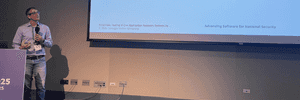One of the aspects I like about my job as a researcher at SEI is that I split my time between being an academic researcher and a software engineer. For example, a few years ago, my colleagues and I published a paper on how to employ logic programming to recover object-oriented abstractions from an executable. I was very proud of that paper (and still am!) because it introduces some interesting new approaches to performing binary analysis, and yet is also a usable tool (OOAnalyzer) that people are actually using to reverse engineer real software.
Although basing our system on logic programming made for an interesting paper, it also made it challenging to scale OOAnalyzer to very large and complex executables. We strugged from the beginning to achieve reasonable performance, and eventually concluded that we had to aggressively use tabling in order to achieve reasonable performance. At a high level, tabling is memoization for Prolog. Prolog does have side-effects, though, and part of the challenge for tabling implementations is to make sure that the tables are consistent.
One of the leading Prolog implementations with tabling support is XSB Prolog, which OOAnalyzer has been using since the beginning. Teri Swift, one of the XSB developers, and the leading expert on Prolog tabling, really helped us get enough performance to be able to write our paper. We were able to analyze some large and interesting programs, including mysql.exe, the MySQL client program. The largest program we were able to test in our paper was over 5 MiB.
Unfortunately, there were many programs that we weren't able to test successfully as well. One of these that really stuck in my mind was mysqld.exe. In our paper, we were able to run successfully on mysql.exe, the MySQL client program, but mysqld.exe, the daemon was much larger (22 MiB vs 5 MiB), and remained elusive.
A while after we published our paper, we started working again with Teri Swift, who was helping Jan Wielemaker of SWI Prolog add support for tabling to SWI Prolog. Teri and Jan wanted to use OOAnalyzer as a test case to make sure that SWI Prolog's tabling implementation was working correctly. Since this would mean that OOAnalyzer would have another supported Prolog engine, this was a win-win situation for us! Jan graciously helped us get OOAnalyzer running on SWI, which was useful in its own right. He also developed some invaluable debugging tools to help us understand what tabling is doing behind the scenes.
These tools, combined with a lot of profiling and rewriting iterations, eventually allowed us to improve performance bottlenecks to the point that we could successfully reason through mysqld.exe and other similarly large programs! Along the way, we battled performance bottlenecks, memory that would not be reclaimed, and other problems. But now we can analyze mysqld.exe in about 18 hours, and only using about 12 GiB of memory. And what is encouraging is that even near the end of reasoning about such a large program, the tool is still making new inferences fairly quickly.
These updates are available in the latest release of the Pharos repository. My colleague Cory Cohen recently wrote a tutorial on how to run OOAnalyzer on large executables, with all of the tricks we have learned over the years.
While working with Teri and Jan, I very slowly began to understand some of the underlying problems that would cause performance to degrade in large programs. One of the problems was that, to maintain consistency, the tabling implementation would re-compute tables from scratch. For most tables, this could be done quickly. But for others, it would take up huge amounts of time. I also realized that because of the structure of our problem, which incrementally learns new conclusions over time, the recomputations were not really needed.
I created a work-around in Prolog that I call "trigger rules". I rewrote the most expensive OOAnalyzer rules to be triggered when dependent facts were introduced, which avoided the costly (and unnecessary) recomputation of the table for all values. The conversion process is fragile and manual, but it proved that if we could avoid the costly recomputations, OOAnalyzer's performance would scale pretty well.
More recently, we've been working with Jan on some a tabling method that avoids the costly recomputations (and also avoids the fragile, error-prone manual transformations that I needed to make for trigger rules). The new type of tabling is called monotonic tabling. There are still some kinks to work out, but we are optimistic that this will further improve the performance of OOAnalyzer and make it easier to maintain.
And of course, monotonic tabling will probably make for an interesting subject of a new paper. So we've now come full circle. We wrote the research paper on OOAnalyzer. This led us to engineering challenges. And to solve the engineering challenges, it brought us back to a new research problem.
Powered with by Gatsby 5.0

